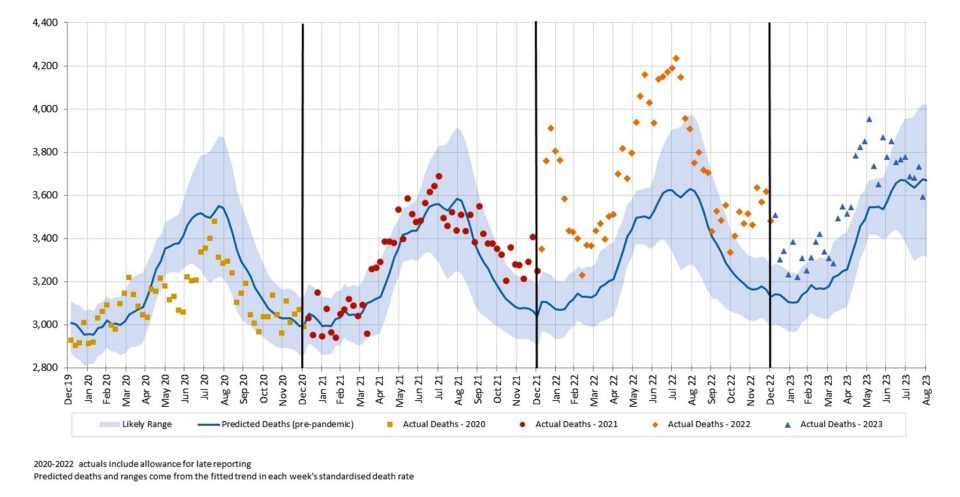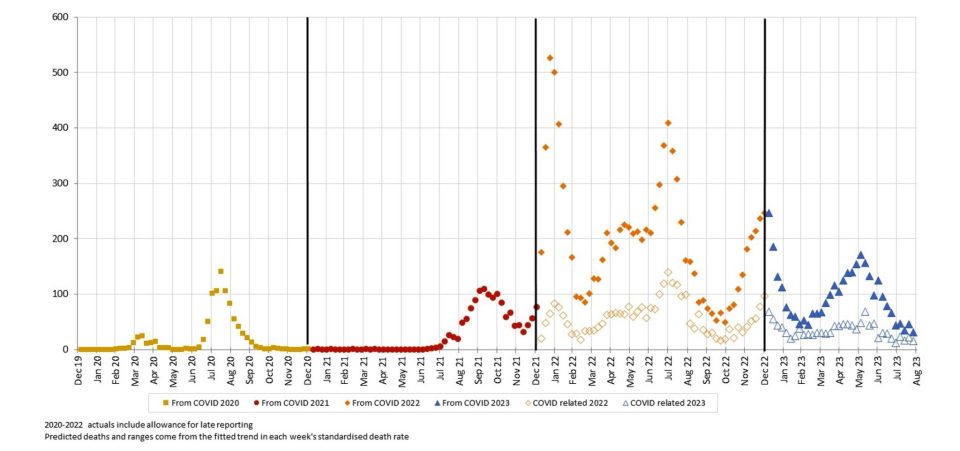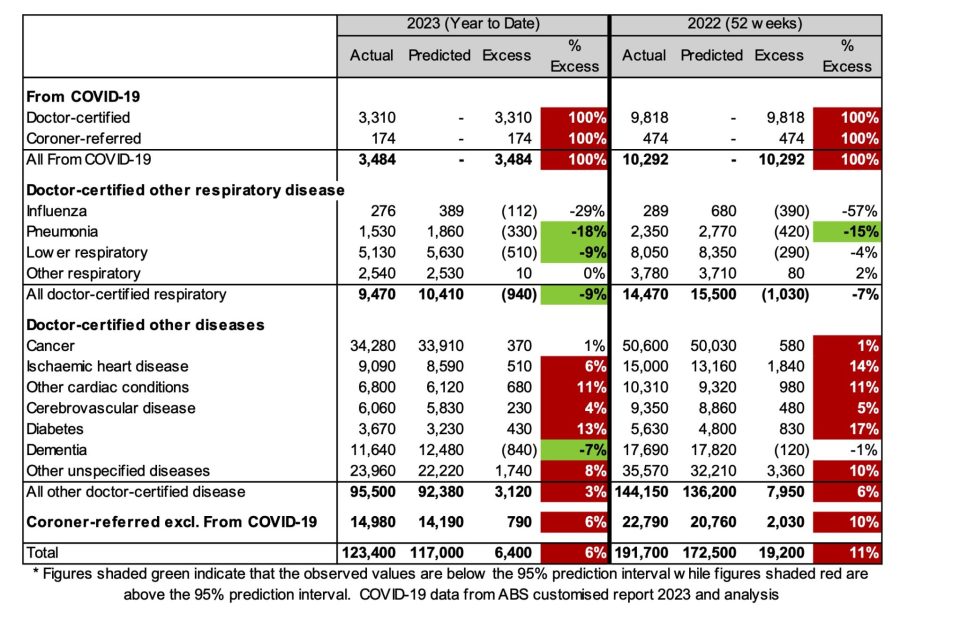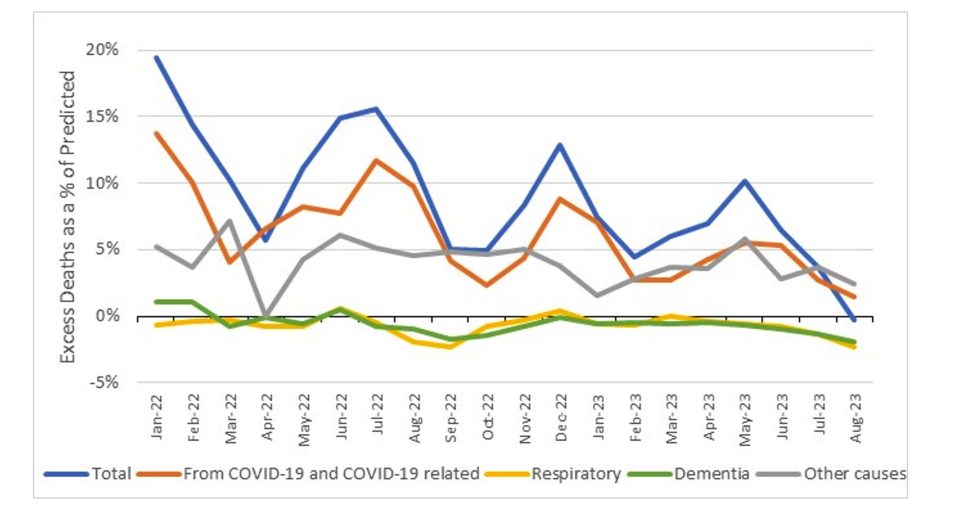
COVID-19 Mortality Working Group – No Excess Mortality for August 2023
Catch up on the Actuaries Institute’s COVID-19 Mortality Working Group’s latest analysis of excess deaths.
In summary:
|
Excess deaths to 31 August 2023
Figure 1 shows the results of our analysis, comparing actual deaths each week to our predicted values and the 95% prediction interval.
Figure 1 – Weekly actual and predicted deaths – all causes

Deaths in all four weeks of August were close to predicted.
Figure 2 shows deaths from COVID-19 and COVID-19 related deaths, noting that, given small numbers, weekly data for COVID-19 related deaths is not available for 2020 or 2021. (We did not request our customised report from the ABS this month, so the weekly COVID-19 deaths for the four weeks of August are an approximation[1].)
Figure 2 – Weekly deaths from COVID-19 and COVID-19 related*

* COVID-19 data until end July from ABS customised report 2023, approximation for August. Predicted COVID-19 deaths are zero as our baseline is intended to represent predicted deaths in the absence of the pandemic.
Deaths from COVID-19 and COVID-19 related deaths were low in August.
Surveillance reporting indicates that COVID-19 deaths remained at low levels in September. Early indications are that COVID-19 deaths started to trend upwards again towards the end of October.
Excess deaths to 31 August 2023 by cause of death
Table 1 shows our estimate of excess deaths broken down by cause. We have shown the figures for the first eight months of 2023 and the full year 2022[2].
Table 1 – Excess deaths in Australia – by cause of death for 2023 to 31 August and for 2022

In the first eight months of 2023:
- total deaths were 6% (95% confidence interval: 4% to 8%) or +6,400 higher than predicted. For the month of August 2023, deaths were 100 lower than predicted (0% excess);
- there were 3,484 deaths from COVID-19, representing 54% of the excess deaths;
- there were 970 COVID-19 related deaths included among the other causes of death, representing a further 15% of the excess deaths. The remaining 31% of excess deaths (c. 2,000) have no mention of COVID-19 on the death certificate;
- deaths from pneumonia, lower respiratory disease and dementia were significantly lower than predicted (by between 7% and 18% respectively); and
- doctor-certified deaths from non-respiratory diseases other than cancer and dementia, and coroner referred deaths, were significantly higher than predicted (by between 4% and 13%).
Deaths from influenza in the eight months were also lower than predicted, but the very wide range of the confidence interval means that the difference is not statistically significant. While not shown in the table, it is worth noting that, in the month of August, there were 33 influenza deaths compared with an expectation of 170. This is the result of the 2023 influenza season in Australia again being earlier (and less severe) than usual.
Lower than expected deaths from respiratory disease and dementia suggest that defensive measures are still providing some protection to aged care residents. If so, it is likely that deaths from COVID-19 are lower than would otherwise have been the case.
Figure 3 shows excess deaths (as a percentage of predicted) for each month of 2022 and 2023. We have shown the total excess (blue) and the contributions of:
- deaths from COVID-19 and COVID-19 related deaths (orange), noting that Figure 2 showed that deaths from these two sources broadly move in the same pattern;
- deaths from respiratory disease (yellow);
- deaths from dementia (green); and
- deaths from all other causes (grey).
Figure 3 – Excess deaths (% of predicted) by month in 2022 and 2023

COVID-19 deaths account for most of the excess mortality.
Deaths from respiratory disease have mostly been a negative contributor to excess mortality. The 2023 flu season was, like 2022, earlier than pre-pandemic normal [3].
Deaths from dementia are correlated with COVID-19 and respiratory deaths. Our Research Paper shows that a high proportion of deaths from dementia have either influenza or COVID-19 listed as a contributory cause, so it is no surprise to see the excess dementia deaths move broadly in line with COVID-19 and influenza waves.
Excess mortality from other causes (i.e., non-COVID-19, non-respiratory), somewhat follows the pattern of COVID-19 mortality; it tends to be higher when COVID-19 (and respiratory) deaths are high and lower when COVID-19 deaths are low. However, the relationship is not 100% correlated – e.g., there was substantial non-COVID-19, non-respiratory excess mortality in September and October 2022 when both COVID-19 and respiratory deaths were relatively low.
Figure 3 shows that, in the month of August 2023, the 0% overall excess mortality was the result of lower than predicted deaths from respiratory disease and dementia, offset by higher than predicted deaths from COVID-19 and other causes. We expect that both respiratory disease and dementia will have similar negative contributions to excess mortality in September 2023 (given that the relatively low prevalence of both COVID-19 and influenza continued into that month).
Data and terminology
The COVID-19 Mortality Working Group has examined the latest Provisional Mortality Statistics, covering deaths occurring prior to 31 August 2023 and registered by 31 October 2023, released by the Australian Bureau of Statistics (ABS) on 24 November. This release is in the ABS’s shortened format reporting (a short format report is released every second month).
We have previously used additional data supplied by the ABS in a customised report in relation to COVID-19 deaths, namely the total number of deaths each week (doctor-certified and coroner-referred) both from COVID-19 and COVID-19 related, defined as:
- deaths from COVID-19 are deaths where COVID-19 is listed as the primary/underlying cause of death; and
- deaths that are COVID-19 related are deaths where the underlying cause of death has been determined as something other than COVID-19, but COVID-19 was a contributing factor mentioned on the death certificate.[4]
As this month’s Provisional Mortality Statistics is a short format report, we did not request the customised report this month.
Baseline predictions
We calculate excess deaths by comparing observed deaths to our “baseline” predicted number of deaths for doctor-certified deaths (by cause) and coroner-referred deaths (for all causes combined). As always, our intent is for the baseline to reflect the expected number of deaths “in the absence of the pandemic”.
The derivation of our baselines and a fuller description of our methodology is documented in our Research Paper. In short, our baselines by cause of death are set by extrapolating linear regression models fitted to Standardised Death Rates (SDRs), which are then re-expressed as numbers of deaths. That means that our baselines allow for changes in the size and age composition of the population, plus the continuation of pre-pandemic mortality trends.
Disclaimer
This monthly COVID-19 mortality analysis is intended for discussion purposes only and does not constitute consulting advice on which to base decisions. We are not medical professionals, public health specialists or epidemiologists.
To the extent permitted by law, all users of the monthly analysis hereby release and indemnify The Institute of Actuaries of Australia and associated parties from all present and future liabilities that may arise in connection with this monthly analysis, its publication or any communication, discussion or work relating to or derived from the contents of this monthly analysis.
COVID-19 Mortality Working Group
The members of the Working Group are:
- Karen Cutter
- Jennifer Lang
- Han Li
- Richard Lyon
- Zhan Wang
- Mengyi Xu
References
[1] The approximation uses the pattern of weekly doctor-certified deaths from COVID-19 in August to spread the monthly numbers of deaths that are from COVID-19 and COVID-19 related.
[2] As in our previous work, we have estimated the number of coroner-referred COVID-19 deaths based on the experience of late 2021 and the emerging experience in 2022. If our estimate of coroner-referred COVID-19 deaths is too high (or low), this will not affect the total level of excess deaths measured; it will just mean that our estimate of non-COVID-19 coroner-referred deaths will be too low (or high) by the same amount.
[3] We can see the impact of the early, lighter than average, influenza season in 2022 with a small contribution to excess mortality in June 2022, more than offset by high negative contributions in August and September 2022 (the months where influenza deaths usually peaked before the pandemic).
[4] The COVID-19 deaths covered in this article are distinct from “incidental COVID-19” deaths, namely deaths where the person was COVID-19 positive at the time of death, but COVID-19 was not recorded on the death certificate. These deaths are generally included in surveillance reporting where identified (other than where there is a clear alternative cause of death, such as trauma) but are not separately identified in the ABS statistics.
CPD: Actuaries Institute Members can claim two CPD points for every hour of reading articles on Actuaries Digital.






